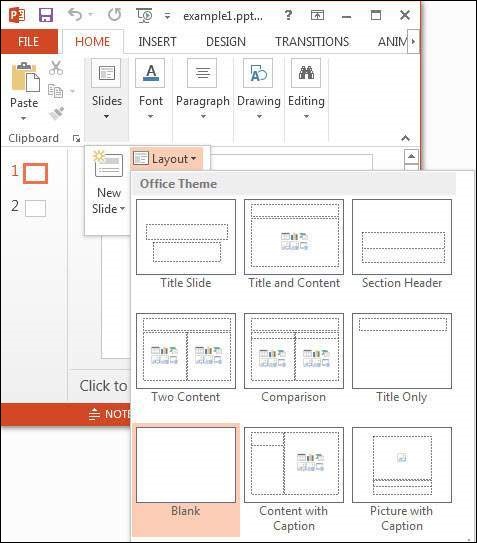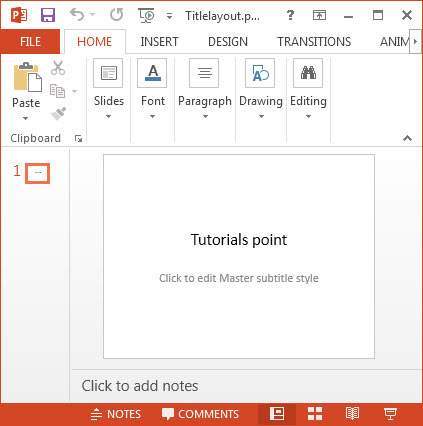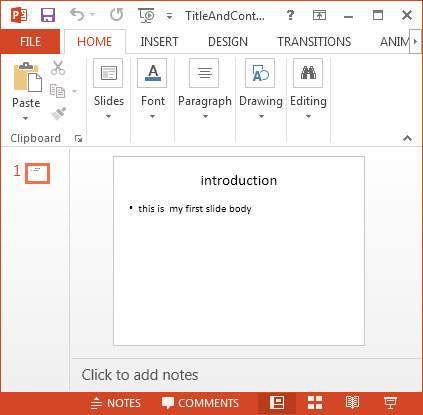
- Apache POI PPT Tutorial
- Apache POI PPT - Home
- Apache POI PPT - Overview
- Apache POI PPT - Java API Flavors
- Apache POI PPT - Installation
- Apache POI PPT - Classes & Methods
- Apache POI PPT - Presentation
- Apache POI PPT - Slide Layouts
- Apache POI PPT - Slide Management
- Apache POI PPT - Images
- Apache POI PPT - Creating Hyperlinks
- Apache POI PPT - Reading Shapes
- Apache POI PPT - Formatting Text
- Apache POI PPT - Merging
- Apache POI PPT - PPT to Image
- Apache POI PPT Resources
- Apache POI PPT - Quick Guide
- Apache POI PPT - Useful Resources
- Apache POI PPT - Discussion
Apache POI PPT - Slide Layouts
In the previous chapter, you have seen how to create empty slides and how to add slides to it. In this chapter, you will learn how to get the list of available slides, and how to create a slide with different layouts.
Available Slide layouts
PowerPoint presentations have slide layouts, and you can choose a desired layout to edit a slide. First of all, let us find out the list of all the slide layouts available.
There are different slide masters and in each slide master, there are several slide layouts.
You can get the list of the slide masters using the getSlideMasters() method of the XMLSlideShow class.
You can get the list of the slide layouts from each slide master using the getSlideLayouts() method of the XSLFSlideMaster class.
You can get the name of the slide layout from the layout object using the getType() method of the XSLFSlideLayout class.
Note − All these classes belongs to org.poi.xslf.usermodel package.
Given below is the complete program to get the list of available slide layouts in the PPT −
import java.io.IOException;
import org.apache.poi.xslf.usermodel.XMLSlideShow;
import org.apache.poi.xslf.usermodel.XSLFSlideLayout;
import org.apache.poi.xslf.usermodel.XSLFSlideMaster;
public class SlideLayouts {
public static void main(String args[]) throws IOException {
//create an empty presentation
XMLSlideShow ppt = new XMLSlideShow();
System.out.println("Available slide layouts:");
//getting the list of all slide masters
for(XSLFSlideMaster master : ppt.getSlideMasters()) {
//getting the list of the layouts in each slide master
for(XSLFSlideLayout layout : master.getSlideLayouts()) {
//getting the list of available slides
System.out.println(layout.getType());
}
}
}
}
Save the above Java code as SlideLayouts.java , and then compile and execute it from the command prompt as follows −
$javac SlideLayouts.java $java SlideLayouts
It will compile and execute to generate the following output −
Available slide layouts: TITLE PIC_TX VERT_TX TWO_TX_TWO_OBJ BLANK VERT_TITLE_AND_TX TITLE_AND_CONTENT TITLE_ONLY SECTION_HEADER TWO_OBJ OBJ_TX
Shown below are some of the sample slide layouts available with MS-Office 360, 2013 edition.

Title Layout
Let us create a slide in a PPT using Title layout. Follow the steps given below −
Step 1 − Create an empty presentation by instantiating the XMLSlideShow class as shown below.
XMLSlideShow ppt = new XMLSlideShow();
Step 2 − Get the list of slide masters using the getSlideMasters() method. Thereafter, select the desired slide master using the index as shown below.
XSLFSlideMaster slideMaster = ppt.getSlideMasters()[0];
Here we are getting the default slide master which is in the 0th location of the slide masters array.
Step 3 − Get the desired layout using the getLayout() method of the XSLFSlideMaster class. This method accepts a parameter where you have to pass one of the static variable of the SlideLayoutclass, which represents our desired layout. There are several variables in this class where each variable represents a slide layout.
The code snippet given below shows how to create a title layout −
XSLFSlideLayout titleLayout = slideMaster.getLayout(SlideLayout.TITLE);
Step 4 − Create a new slide by passing a slide layout object as parameter.
XSLFSlide slide = ppt.createSlide(titleLayout);
Step 5 − Select a placeholder using the getPlaceholder() method of the XSLFSlide class. This method accepts an integer parameter. By passing 0 to it, you will get the XSLFTextShape object, using which you can access the title text area of the slide. Set the title using the setText() method as shown below.
XSLFTextShape title1 = slide.getPlaceholder(0);
//setting the title init
title1.setText("Tutorials point");
Given below is the complete program to create a slide with Title layout in a presentation −
import java.io.File;
import java.io.FileOutputStream;
import java.io.IOException;
import org.apache.poi.xslf.usermodel.SlideLayout;
import org.apache.poi.xslf.usermodel.XMLSlideShow;
import org.apache.poi.xslf.usermodel.XSLFSlide;
import org.apache.poi.xslf.usermodel.XSLFSlideLayout;
import org.apache.poi.xslf.usermodel.XSLFSlideMaster;
import org.apache.poi.xslf.usermodel.XSLFTextShape;
public class TitleLayout {
public static void main(String args[]) throws IOException {
//creating presentation
XMLSlideShow ppt = new XMLSlideShow();
//getting the slide master object
XSLFSlideMaster slideMaster = ppt.getSlideMasters().get(0);
//get the desired slide layout
XSLFSlideLayout titleLayout = slideMaster.getLayout(SlideLayout.TITLE);
//creating a slide with title layout
XSLFSlide slide1 = ppt.createSlide(titleLayout);
//selecting the place holder in it
XSLFTextShape title1 = slide1.getPlaceholder(0);
//setting the title init
title1.setText("Tutorials point");
//create a file object
File file = new File("F://Titlelayout.pptx");
FileOutputStream out = new FileOutputStream(file);
//save the changes in a PPt document
ppt.write(out);
System.out.println("slide cretated successfully");
out.close();
}
}
Save the above Java code as TitleLayout.java, and then compile and execute it from the command prompt as follows −
$javac TitleLayout.java $java TitleLayout
It will compile and execute to generate the following output.
slide created successfully
The PPT document with newly added Title layout slide appears as follows −

Title and content Layout
Let us create a slide in a PPT using Title and content layout. Follow the steps given below.
Step 1 − Create an empty presentation by instantiating the XMLSlideShow class as shown below.
XMLSlideShow ppt = new XMLSlideShow();
Step 2 − Get the list of slide masters using the getSlideMasters() method. Select the desired slide master using the index as shown below.
XSLFSlideMaster slideMaster = ppt.getSlideMasters()[0];
Here we are getting the default slide master which is in the 0th location of the slide masters array.
Step 3 − Get the desired layout using the getLayout() method of the XSLFSlideMaster class. This method accepts a parameter where you have to pass one of the static variable of the SlideLayout class which represents our desired layout. There are several variables in this class that represent slide layouts.
The following code snippet shows how to create title and content layout −
XSLFSlideLayout contentlayout = slideMaster.getLayout(SlideLayout.TITLE_AND_CONTENT);
Step 4 − Create a new slide by passing the slide layout object as parameter.
XSLFSlide slide = ppt.createSlide(SlideLayout.TITLE_AND_CONTENT);
Step 5 − Select a placeholder using the getPlaceholder() method of the XSLFSlide class. This method accepts an integer parameter. By passing 1 to it, you will get the XSLFTextShape object, using which you can access the content area of the slide. Set the title using the setText() method as shown below.
XSLFTextShape title1 = slide1.getPlaceholder(1);
//setting the title init
title1.setText("Introduction");
Step 6 − Clear the existing text in the slide using the clearText() method of the XSLFTextShape class.
body.clearText();
Step 7 − Add new paragraph using the addNewTextParagraph() method. Now add a new text run to the paragraph using the addNewTextRun() method. Now to the text run, add text using the setText() method as shown below.
body.addNewTextParagraph().addNewTextRun().setText("this is my first slide body");
Given below is the complete program to create a slide with Title layout in a presentation −
import java.io.File;
import java.io.FileOutputStream;
import java.io.IOException;
import org.apache.poi.xslf.usermodel.SlideLayout;
import org.apache.poi.xslf.usermodel.XMLSlideShow;
import org.apache.poi.xslf.usermodel.XSLFSlide;
import org.apache.poi.xslf.usermodel.XSLFSlideLayout;
import org.apache.poi.xslf.usermodel.XSLFSlideMaster;
import org.apache.poi.xslf.usermodel.XSLFTextShape;
public class TitleAndBodyLayout {
public static void main(String args[]) throws IOException {
//creating presentation
XMLSlideShow ppt = new XMLSlideShow();
//getting the slide master object
XSLFSlideMaster slideMaster = ppt.getSlideMasters().get(0);
//select a layout from specified list
XSLFSlideLayout slidelayout = slideMaster.getLayout(SlideLayout.TITLE_AND_CONTENT);
//creating a slide with title and content layout
XSLFSlide slide = ppt.createSlide(slidelayout);
//selection of title place holder
XSLFTextShape title = slide.getPlaceholder(0);
//setting the title in it
title.setText("introduction");
//selection of body placeholder
XSLFTextShape body = slide.getPlaceholder(1);
//clear the existing text in the slide
body.clearText();
//adding new paragraph
body.addNewTextParagraph().addNewTextRun().setText("this is my first slide body");
//create a file object
File file = new File("contentlayout.pptx");
FileOutputStream out = new FileOutputStream(file);
//save the changes in a file
ppt.write(out);
System.out.println("slide cretated successfully");
out.close();
}
}
Save the above Java code as TitleLayout.java, and then compile and execute it from the command prompt as follows −
$javac TitleLayout.java $java TitleLayout
It will compile and execute to generate the following output −
slide created successfully
The PPT document with newly added Title layout slide appears as follows −

In the same way, you can create slides with different layouts as well.